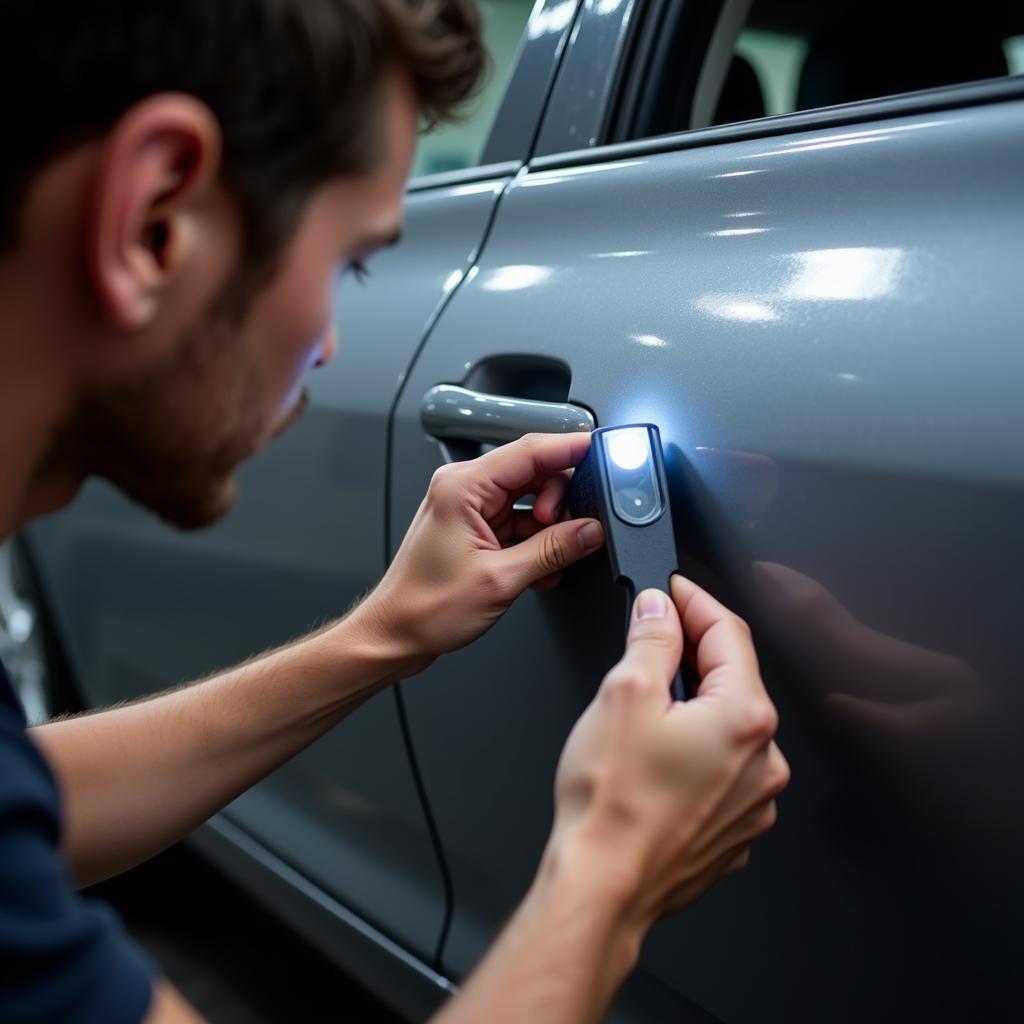Car body repair can seem daunting, but with the right tools, you can tackle many common issues yourself. Whether you’re dealing with minor dents, scratches, or more significant damage, understanding the function and application of various tools is key. This guide covers essential Tools To Repair Car Body damage, empowering you to restore your vehicle’s appearance and potentially save money on professional repairs. car body repair tools
Understanding the Basics of Car Body Repair
Before diving into specific tools, it’s crucial to understand the basic principles of car body repair. The process typically involves assessing the damage, preparing the area, making the necessary repairs, and finishing with paint and detailing. Each step requires different tools, and choosing the correct ones will significantly impact the final result.
Assessing the Damage: The First Step
Accurately assessing the damage is the foundation of any successful car body repair. This involves identifying the type of damage, its extent, and the best approach for repair. Is it a minor scratch that can be buffed out, a dent requiring pulling or filling, or more serious structural damage needing professional attention?
 Assessing Car Body Damage for Repair
Assessing Car Body Damage for Repair
Tools for Minor Dent Repair: PDR and More
Minor dents, often caused by hail or shopping carts, can be frustrating. Paintless dent repair (PDR) offers an effective solution, utilizing specialized tools to manipulate the metal back to its original shape without affecting the paint.
PDR Tools: Your Go-To for Minor Dents
PDR tools include various shapes and sizes of dent pullers, glue tabs, and knock-down tools. These tools allow technicians to access the dent from behind and gently massage the metal back into place.
For smaller dings and dents, suction cups can sometimes be effective. car body pdr paintless dent repair tools While not as comprehensive as a full PDR kit, a good quality suction cup can offer a quick fix for superficial damage.
Tools for Scratch and Chip Repair
Scratches and chips are common occurrences, often caused by rocks, road debris, or even careless key scratches. Fortunately, there are tools specifically designed to address these blemishes.
Fixing Scratches: From Touch-Up Paint to Polishing Compounds
Touch-up paint is a must-have for addressing small chips and scratches. Choose a paint that precisely matches your vehicle’s color code for seamless repair. For deeper scratches, a polishing compound can help to level the surface and reduce their visibility.
Tools for More Extensive Bodywork
More extensive body damage, such as rust or large dents requiring body filler, necessitate different tools.
Tackling Rust: Grinders, Wire Brushes, and Rust Converters
Rust repair often involves removing the affected metal with a grinder or wire brush, then treating the area with a rust converter before applying body filler. tools for car body repair This process requires specialized tools and safety precautions.
Body Filler and Shaping Tools: Sandpaper, Spreaders, and Files
Body filler is used to fill in dents and imperfections. Applying and shaping body filler requires specialized spreaders and files, followed by sanding to create a smooth, even surface. ebay car body repair tools Finding reliable tools from reputable sellers ensures quality and durability. car body paintless dent repair tool Investing in quality tools can significantly impact the effectiveness of your dent repair efforts.
Conclusion
Having the right tools to repair car body damage can empower you to address many common issues yourself. From minor dents and scratches to more extensive rust and body filler work, understanding the function and application of each tool is essential. By investing in quality tools and following proper techniques, you can restore your vehicle’s appearance and save on costly professional repairs. Remember to always prioritize safety and wear appropriate protective gear during any car body repair project.
FAQs
-
What is PDR?
PDR stands for Paintless Dent Repair, a method for removing minor dents without affecting the original paint. -
Can I fix rust myself?
Yes, minor rust can often be repaired DIY, but extensive rust may require professional attention. -
What type of sandpaper should I use for body filler?
Start with a coarser grit (e.g., 80-grit) and gradually move to finer grits (e.g., 220-grit) for a smooth finish. -
What is the best way to match touch-up paint?
Use your vehicle’s color code, typically found on a sticker inside the driver’s side doorjamb or under the hood. -
Do I need special tools for PDR?
Yes, PDR requires specialized tools like dent pullers, glue tabs, and knock-down tools. -
What safety precautions should I take when repairing car body damage?
Always wear safety glasses, gloves, and a dust mask when grinding, sanding, or working with chemicals. -
Where can I find reliable car body repair tools?
Reputable auto parts stores and online retailers offer a wide selection of quality car body repair tools.
Need assistance with your car diagnostics or repairs? Contact us via WhatsApp: +1(641)206-8880, Email: [email protected], or visit us at 910 Cedar Lane, Chicago, IL 60605, USA. Our 24/7 customer support team is ready to help.

Leave a Reply